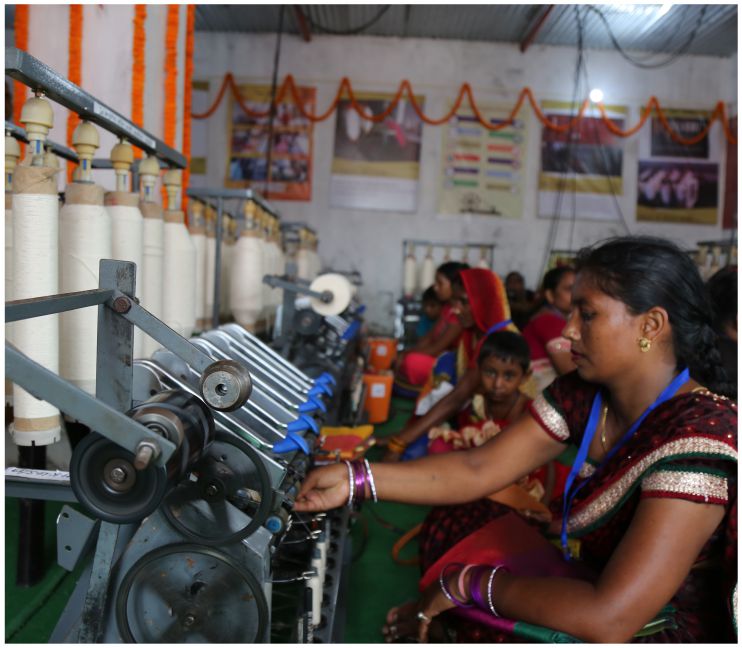Lack of understanding of solar-powered products and unreliability of the technology are key concerns while financing solar-powered livelihood appliances for rural micro enterprises. Bankers are also skeptical of the techno-commercial viability of proposals—according to a report by the Council on Energy, Environment and Water (CEEW).
Financial institutions also cite concerns regarding the cost of evaluating and recollecting loans. The loan size for small solar-powered livelihood appliances ranges from Rs30,000-80,000, making it a relatively small loan with higher administrative costs for banks.
As of 2015–16, rural India is home to over 32 million unincorporated non-agriculture micro enterprises that are involved in various kinds of value addition—from agro-processing and custom tailoring to petty shops and restaurants. These rural micro enterprises represent a big market for decentralised renewable energy powered livelihood appliances that stand to improve their productivity.
The CEEW report entitled ‘Financing Solar-powered Livelihoods in India: Evidence from Micro Enterprises—in collaboration with the SELCO Foundation and supported by the Good Energies Foundation—helps financiers understand the economic viability of solar-powered livelihood technologies for these enterprises. It also assesses the prevailing policy solutions and provides recommendations for the private sector, policymakers and donors to improve access to finance for end-users of such products.
Impact of solarisation
Most tailoring enterprises can recover their investment from solarising their sewing machines in less than two years. Tailoring enterprises experienced an increase of about Rs25,000, on average, in their annual income after solarising their sewing machines. In the case of digital service centres called Lok Seva Kendras (LSKs), entrepreneurs experienced a median increase of about Rs20,000 per annum in income.
The median payback period for sewing machines is just 11 months, whereas that for LSK is 15 months.
Further, about 61% of existing tailoring enterprises and 65% of existing LSK enterprises are able to repay the product loan from their increased incomes. The remaining entrepreneurs pay 30-50% of their new overall income towards loans.
Key recommendations
The report stated that entrepreneurs paying 50% of their income on loans could find it challenging to sustain this level of pay-out. “This should be an important consideration for both entrepreneurs and financiers while determining the loan amount,” it suggested to improve the economic viability of financing for end-users.
Further, the report suggested to focus more on loan tenure instead of rate of interest. “An extended loan tenure increases feasibility and ease of repayment for the entrepreneur (and reduces the likelihood of default), while having only a marginal impact on the economic viability (measured as discounted payback period) for the financier,” it highlighted.
“For relatively lower loan amounts (less than Rs5 lakh), longer tenures would be beneficial, despite higher interest rates,” it said.
Other recommendations include creating awareness about solar-powered livelihood technologies and their economic value, improving quality of technology and after-sales repair and maintenance services to reduce the risk perception of financiers, and accounting for seasonal variations in income to avoid delays in load repayments. Financiers could also adopt alternative and innovative loan collection mechanisms to enable more frequent and flexible repayments.
The CEEW report analyses the financiers’ perspective in lending for solar-powered livelihood appliances in India. It generates evidence on the impact of solar-powered productive-use technologies on the net incomes of end-users and their loan repayments. This helps financiers understand the economic viability of these technologies. It also assesses the prevailing policy solutions and provides recommendations for the private sector, policymakers and donors to improve access to finance for end-users of such products.
This content is protected by copyright and may not be reused. If you want to cooperate with us and would like to reuse some of our content, please contact: editors@pv-magazine.com.









By submitting this form you agree to pv magazine using your data for the purposes of publishing your comment.
Your personal data will only be disclosed or otherwise transmitted to third parties for the purposes of spam filtering or if this is necessary for technical maintenance of the website. Any other transfer to third parties will not take place unless this is justified on the basis of applicable data protection regulations or if pv magazine is legally obliged to do so.
You may revoke this consent at any time with effect for the future, in which case your personal data will be deleted immediately. Otherwise, your data will be deleted if pv magazine has processed your request or the purpose of data storage is fulfilled.
Further information on data privacy can be found in our Data Protection Policy.